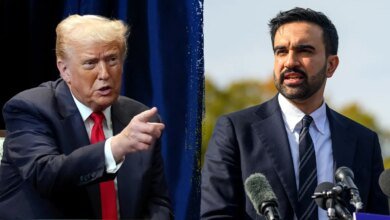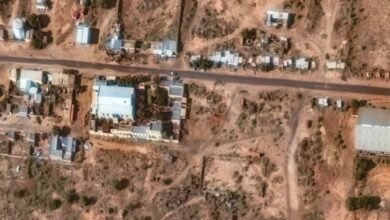After Trump, Xi Meet, New Trade Deal Is a Cease-Fire, Not a Peace

China and the United States have agreed to a one-year truce in their trade war, but it is essentially just a handshake between Presidents Donald Trump and Xi Jinping, rather than an actual agreement. The two leaders met Thursday in Busan, South Korea, where Trump backed away from his threat two weeks ago to raise tariffs by an additional 100% and instead cut average duties from 57% to 47%.
In exchange, Beijing agreed to buy US soybeans again and refrain from imposing further controls on rare earth elements for a year. The two sides backed away from a back-and-forth on port fees that could have reduced global maritime traffic. By Trump’s own admission, the Taiwan issue has not even been discussed.
China and the United States have agreed to a one-year truce in their trade war, but it is essentially just a handshake between Presidents Donald Trump and Xi Jinping, rather than an actual agreement. The two leaders met Thursday in Busan, South Korea, where Trump backed away from his threat two weeks ago to raise tariffs by an additional 100% and instead cut average duties from 57% to 47%.
In exchange, Beijing agreed to buy US soybeans again and refrain from imposing further controls on rare earth elements for a year. The two sides backed away from a back-and-forth on port fees that could have reduced global maritime traffic. By Trump’s own admission, the Taiwan issue has not even been discussed.
Details remain vague and reversible. While Trump has made some larger claims, such as Beijing agreeing to buy farm equipment, gas and oil from Alaska, Chinese statements have been far more cautious. Compare this week’s news to the “Phase One” trade deal signed between the two powers in January 2020. Although the bulk of that agreement never materialized, thanks in large part to the COVID-19 pandemic, it was a fairly detailed arrangement complete with clear demands, mechanisms, and timelines for implementation — something that had been reached in lengthy negotiations several months earlier.
The schedule here simply did not allow for that; While the two sides have been talking since their meetings in Switzerland in May, Trump’s outburst over rare earths, in which he accused China of “becoming very hostile,” came only three weeks ago. This has left the situation much longer on vague promises than details – with many of those promises on already-known topics such as fentanyl. Measures taken by China to limit the export of raw materials over the past decade have not stagnated complaints from Washington.
For now, it appears that Chinese hawks in Washington have succeeded in pushing Trump to back down from allowing the export of Nvidia’s powerful semiconductor chip, the B30A, to Beijing. The AI race is a rare case where China still needs what the US sells, rather than the other way around, and the B30A far outperforms the stripped-down chips currently allowed for sale. But Nvidia CEO Jensen Huang is pressing Trump for more charitable rules, and the possibility of exporting the chip isn’t completely off the table.
One of the few actual numbers provided so far relates to soybeans, where, according to US Treasury Secretary Scott Besent, China has promised to buy 12 million tons in the next few months and another 25 million tons each year for the next three years – roughly the same numbers as in the past two years. This took the threat to “our great soybean farmers” off the table, Besant claimed.
This seems counterintuitive: Mostly, what the deal did highlights to Beijing that this is a political leverage point that it can continue to pressure the United States when it wants to do something. Beijing also realizes that it has plenty of suppliers in South America eager and willing to undercut American farmers.
The silver lining from the long-awaited first meeting between Trump and Xi in six years is that their summit now allows their delegates to sit down for the lengthy and exhausting talks that will be necessary to reach a lasting written agreement. This is the opposite of the usual process, where the attractive top is the final seal on the deal.
But this is consistent with what Trump seems to want from these high-level rallies, which is to appear statesmanlike and get praise from others without paying attention to the details. Both the Japanese and Koreans understood the mission here in their meetings with Trump earlier in the week, but it is also an indicator of how the power dynamic between the United States and China is shifting toward Beijing. Trump was full of praise for Xi, rating the meeting a “12 out of 10” and calling it a “great honor.” The Chinese language was much more silent.
On the pessimistic side, the ambiguity of the deal means, as I wrote earlier this week, that it will only go through until something enrages Trump — or until one of the many other points of friction in the relationship causes a clash. Think of it more like a temporary ceasefire in a protracted war than a peace agreement that could collapse at any moment.
Right now, the United States is relying more on Chinese goodwill than vice versa, especially when it comes to rare earth elements, an area that China has a monopoly on, especially when it comes to processing. Trump’s only real tool is to change the direction of tariffs, and surprisingly, Chinese manufacturers have been able to find other markets to replace the United States.
The United States lacks the government capacity to reform its structural dependence on China. For example, rare earth elements have been a known vulnerability for more than a decade, and despite constant talk about them in Washington, not much has changed. Government work generally requires a government that is open for business.
Don’t miss more hot News like this! Click here to discover the latest in Politics news!
2025-10-30 16:25:00




